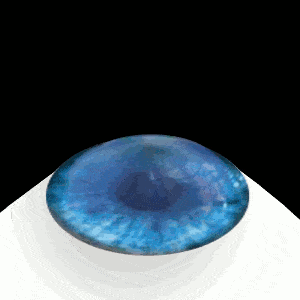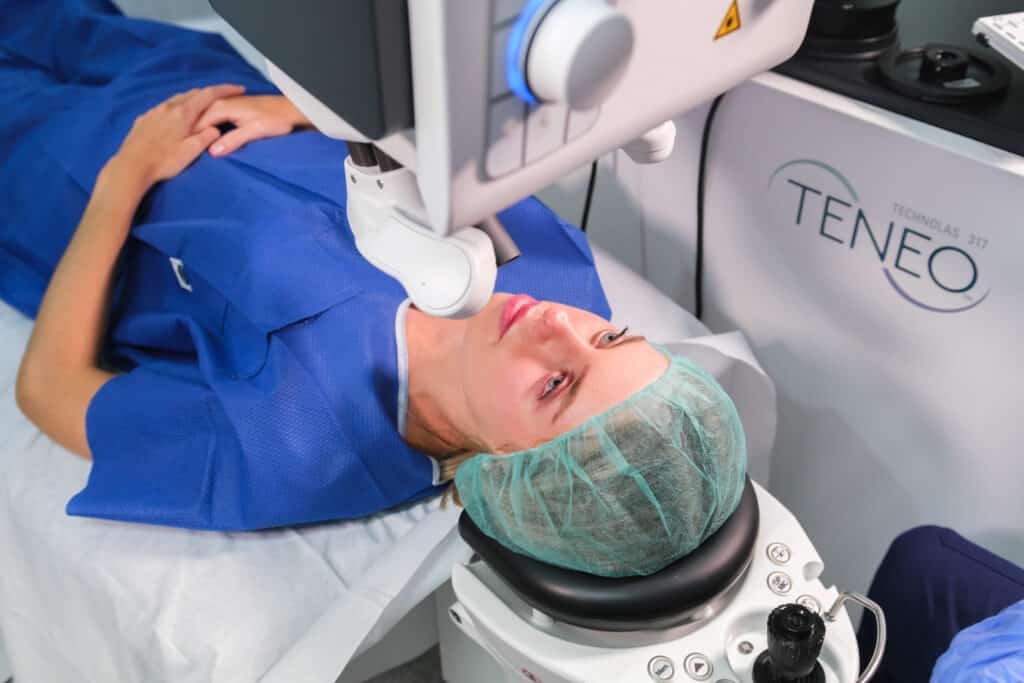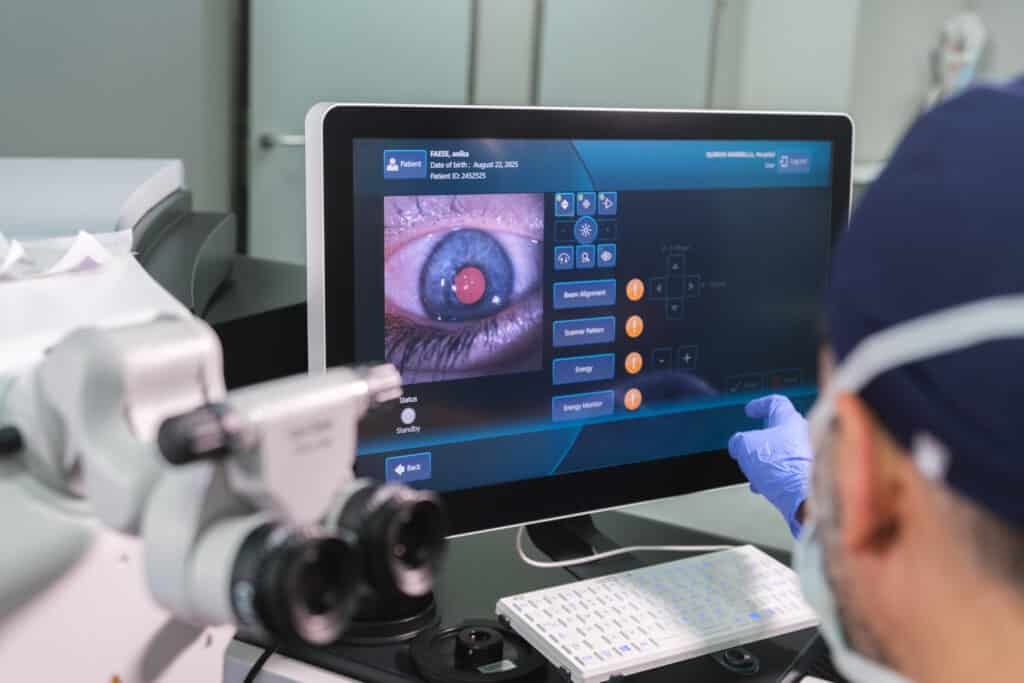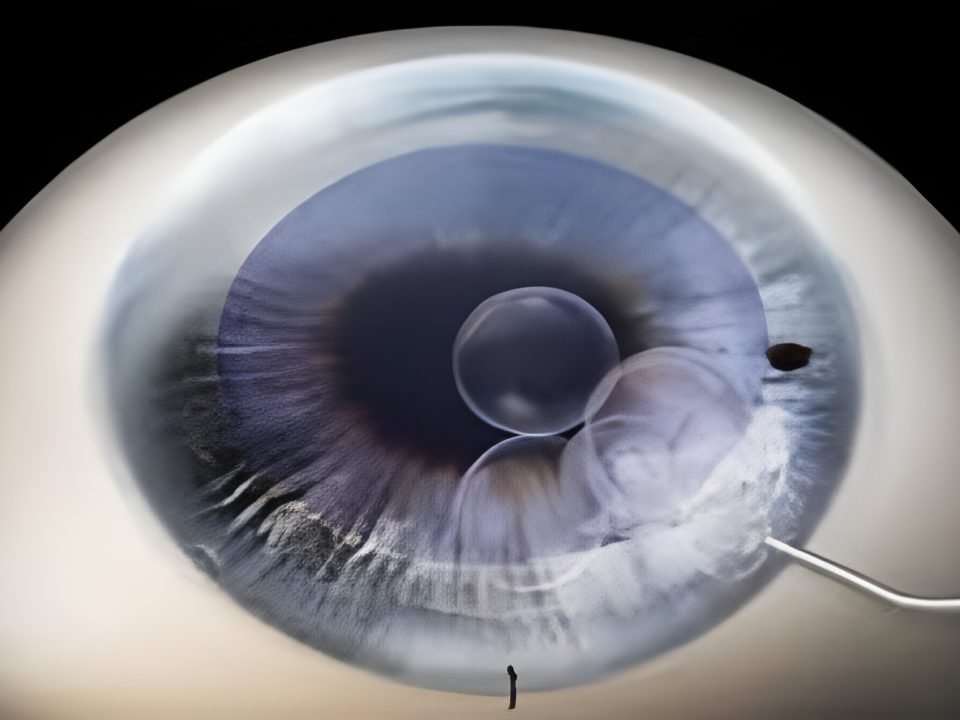The femtosecond laser is an advanced technology in the field of surgery eyepiece. Its millimetre precision allows incisions to be made in the cornea with great safety and efficiency. This type of laser has revolutionised techniques such as the surgery refractive and the cataract surgery. Their applications will be explored throughout this article, advantages and key issues for those considering this surgical option.
What is the femtosecond laser?
Today, the femtosecond laser stands out as one of the most advanced innovations more precise in the field of eye surgery. This device is based on the emission of extremely short pulses of light, allowing millimetre-sized cuts to be made in ocular tissues. A femtosecond is one billionth of a second, which means that thousands of pulses can be sent in a very short time.

The ability to perform microincisions with unparalleled precision is a key point in its operation. Thanks to this technology, tissue can be separated without causing damage to the surrounding areas. This approach minimises the risk of complications, a fundamental aspect of any surgical procedure.
An innovative feature of the laser from femtosecond is his ability to tailor the cuts to the specific needs of each patient. Customisation is essential in eye surgery, where the anatomy of each eye can vary significantly. Because of its precision, the laser reduces the margin of error, making the procedure safer and more effective.
The use of this laser is not only limited to refractive surgery. It has been extended to other eye procedures, making it a versatile tool in modern ophthalmology. Its applications include the operation of cataracts and the treatment of corneal diseases, showing its ability to improve visual health in different contexts.
- Extreme cutting precision.
- Minimisation of complications related to ocular tissue.
- Versatility in various surgical procedures.
Femtosecond laser applications in eye surgery
This type of laser has revolutionised the way in which various interventions are carried out in the field of ophthalmology. Its ability to make precise cuts makes it an essential tool in various eye surgeries. Among its most prominent applications are refractive surgery and cataract surgery.
In the refractive surgery, is mainly used to create the corneal flap. This process is essential for treating vision problems such as myopia, hyperopia and astigmatism. Thanks to the femtosecond laser, surgeons are able to obtain more results safe and effective, with faster visual recovery compared to traditional techniques.
On the other hand, in the cataract surgery, The laser is used to make incisions and fragment the opaque lens. This facilitates the removal of the cataract and allows for more precise insertion of intraocular lenses. The procedure thus becomes safer and more efficient, minimising complications and speeding up the recovery process.
- Refractive surgeryCorrection of refractive problems through the creation of the corneal flap.
- Cataract surgeryPrecise incisions and fragmentation of the crystalline lens for a safer procedure.
- Other usesCorneal transplants and treatments for diseases such as keratoconus, where controlled incisions are made.
Femtosecond laser applications are not only limited to refractive and cataract surgery. They are also used in procedures related to corneal transplantation. In these cases, the laser allows the creation of precise incisions that are necessary to perform corneal tissue implantation, helping to restore patients' vision.
With its versatility, the femtosecond laser has enabled ophthalmologists to address a wide range of eye problems. This makes it a vital tool in daily practice, significantly improving outcomes for patients seeking to restore their visual health.
Femtosecond laser accuracy and results
The femtosecond laser's precision stands out as one of its main features. This technology allows millimetre-accurate cuts to be made with exceptional precision, which contributes to the reduction of complications during eye surgery. The ability to work without thermal effects minimises the risk of damaging the surrounding tissue, which is essential in procedures as delicate as corneal procedures.
The results obtained with this technique are widely recognised. Many patients report significant improvements in their vision after femtosecond laser surgery. Some of the most notable benefits include:
- Rapid visual recoveryCompared to previous techniques, patients often experience a faster recovery.
- Practicality of resultsPrecision cutting allows for more predictable and consistent results.
- Reducing the risk of complicationsThe non-thermal nature of the laser reduces the possibility of postoperative adverse effects.
Studies over the years have shown that the efficacy of procedures using this type of laser results in a high degree of patient satisfaction. Success rates in the correction of myopia, hyperopia and astigmatism are notoriously high. All this translates into greater confidence for both surgeons and patients who opt for this technological innovation.
The femtosecond laser has revolutionised the field of eye surgery. More and more specialists consider it the preferred choice for refractive and cataract surgery. This selection is due not only to its high precision, but also to the positive results that clinical studies continue to demonstrate. The adoption of this technique has changed the paradigm of how eye procedures are performed, offering a brighter future for those seeking to improve their vision.
Requirements and contraindications for femtosecond laser surgery
Not all patients are ideal candidates for femtosecond laser surgery. Evaluation of specific factors is crucial to ensure the safety and efficacy of the procedure. There are certain conditions that may limit or preclude this intervention.
Basic requirements include:
- Minimum agePatients must be at least 18 years old, as the ocular structures continue to develop until this age.
- Stable conditionsVision must be stabilised for at least one year. This is essential to ensure predictable results.
- General eye healthNo active eye infections or diseases at the time of assessment.
On the other hand, there are conditions that may disqualify a patient for this type of surgery. Some of these contraindications include:
- High refractive errorsPatients with very high myopia, hyperopia or astigmatism are not always candidates because of the increased risk of complications.
- Irregular or thin corneasThose with corneas that have abnormalities or are too thin may be at increased risk when undergoing this procedure.
- Dry eye syndromeDry eye: People suffering from severe dry eye may experience an increase in postoperative complications, which may affect recovery.
- Autoimmune disordersAutoimmune diseases can alter the body's response to surgery, necessitating further evaluation.
It is vital that each patient undergoes a detailed assessment by the ophthalmologist to determine their suitability for surgery. This includes a thorough eye health analysis and a discussion of the potential risks and benefits of the procedure. A personalised approach will help ensure that informed and safe decisions are made regarding femtosecond laser surgery.
Importantplanning should be carried out with a refractive surgery specialist with full training, rather than a general ophthalmologist. These professionals have international qualifications and accreditations that endorse their level of specialisation, such as FEBOS-CR (Fellow of the European Board of Ophthalmology in Refractive Surgery) and FWCRS (Fellow of the World College of Refractive Surgeons). This advanced level of training ensures a more accurate assessment, personalised planning and greater safety throughout the surgical process. In this respect, Dr. Ali Nowrouzi, ophthalmologist in Marbella, offers a specialisation in femtosecond laser refractive and cataract surgery, backed by extensive clinical experience and international training.
His approach combines technological precision with a personalised assessment of each patient, ensuring predictable, safe results tailored to the visual needs of each case. Thanks to his track record and accreditations, Dr. Nowrouzi has established himself as a reference in advanced eye treatments on the Costa del Sol.

Preparation for femtosecond laser surgery
Proper preparation is essential to ensure the success of the surgery. There are several steps to take to ensure that everything is in place before the procedure. This process begins weeks before the scheduled date.
A crucial aspect is the discontinuation of contact lens wear. It is recommended to stop wearing contact lenses at least two weeks before surgery. This is essential, as lenses can alter the shape of the cornea, affecting the accuracy of the procedure. Recovery and patient safety are the top priorities.
Another important detail is to avoid using make-up in the eye area. This advice applies both on the day of surgery and the day before. Keeping the eyes clean helps to minimise the risk of infection and complications during surgery.
It is advisable to maintain proper eye hygiene. The use of moisturising drops is beneficial and should be used to keep the ocular surface well hydrated. This care helps to create an environment conducive to surgery.
Adequate rest before the procedure is also vital. Getting a good night's sleep the night before has a positive impact on the patient's overall condition, allowing them to be more relaxed and focused on the day of surgery.
- Do not wear eye make-up the day before and on the date of surgery.
- Stop wearing contact lenses at least two weeks before.
- Use moisturising drops regularly to keep eyes hydrated.
- Get a good night's sleep before the procedure to arrive rested.
By following these preparation steps, risks can be mitigated and a smoother surgical experience ensured. Patient collaboration in this process is key to achieving the best possible outcomes.
Surgical process step by step
On the day of surgery, the patient arrives at the clinic in good physical condition. It is essential not to wear eye make-up and to have stopped wearing contact lenses at least two weeks before the procedure. These previous steps guarantee a safer and more effective intervention.
Once at the clinic, the medical staff takes the patient to a preparation area where a local anaesthetic will be administered. This type of anaesthetic ensures that there is no pain during the procedure.
The standard procedure takes 10 to 15 minutes. The surgeon uses the laser to create the corneal flap or make the necessary incisions. This part is crucial to ensure that the treatment is precise and effective. The use of ultra-short pulses of light allows these incisions to be made with great accuracy, preserving the surrounding tissue.
- After the incisions, the flap is gently lifted and then corrected with another laser, if necessary.
- Once the treatment is completed, the flap is put back in place, where it fits perfectly thanks to the precision of the laser.
Patients are usually awake throughout the procedure, as the local anaesthesia is sufficient to keep them comfortable. During this phase, they may be asked to look towards a point of light to facilitate the laser focus.
After the operation is completed, each patient is provided with goggles to protect the eyes. This is important to avoid any irritation or damage to the eyes immediately after the operation. It is also recommended that the patient rests at home for the rest of the day, minimising any eye strain.
Care and follow-up after femtosecond laser surgery
Recovery after surgery is an important process to ensure the success of the treatment. It is essential to follow certain recommendations to optimise healing and minimise the risk of complications. In this regard, the first recommendation is to avoid using make-up on the eye area for at least one week after the operation. This helps to prevent infection and other problems.
The use of eye drops and prescribed medications must be rigorous. These prescriptions usually include eye drops to keep the eye hydrated and prevent infection. The key is to use the products as prescribed by the doctor, without omitting any doses.
Periodic reviews
It is equally important to attend scheduled follow-up appointments. These check-ups allow the specialist to monitor recovery and take further action if necessary. Any unusual symptoms, such as severe pain or persistent blurred vision, should be reported to the doctor immediately.
Daily care
During the first few days, it is recommended to get enough rest and avoid activities that require visual effort, such as reading or using electronic devices. Keeping the eye protected is essential, so it is advisable to wear sunglasses to protect it from intense light and dust outdoors.
Additional advice
- Avoid rubbing your eyes with your hands.
- Do not swim in swimming pools or the sea until confirmed by a doctor.
- Follow a healthy diet that promotes ocular recovery.
- Report any changes in vision or discomfort.
As time passes, the eye will recover and results will begin to be evident. Maintaining good communication with your eye care professional will facilitate proper follow-up, which promotes a successful outcome.

Femtosecond laser price and accessibility information
The cost of femtosecond laser treatment can vary depending on several factors, such as the clinic, the surgeon's experience and the complexity of the case. In general, prices range from 1,300 to 3,500 euros per eye, reflecting the investment in state-of-the-art technology and the specialised care provided. It is important to consider that these prices may include pre-operative consultations, post-operative follow-up and other additional services.
The accessibility of this type of surgery has improved in recent years. Many clinics, including those in Marbella, offer financing options and payment plans, making the treatment more affordable for more people. These facilities allow the patient to undergo the procedure without cost being a major obstacle.
- Free consultationSeveral clinics offer an initial consultation free of charge, where the patient's eye health is assessed to determine if he or she is suitable for treatment.
- Promotions and discounts: Often, there are special offers that can reduce the total price of the procedure.
- Financing optionsSome clinics have agreements with financial institutions that allow you to pay in easy instalments.
It is essential to find out what is included in the price of treatment. When selecting a clinic, aspects such as the quality of care, the medical team and the post-operative services included should be considered, as these markers are essential to ensure a satisfactory and safe experience.
With the advancement of technology, the femtosecond laser has been gaining popularity in the field of eye surgery, and its accessibility is constantly improving. Evaluating the different options available and understanding the payment conditions can facilitate the decision to opt for this type of intervention, leading to a significant improvement in the patient's visual quality of life.







